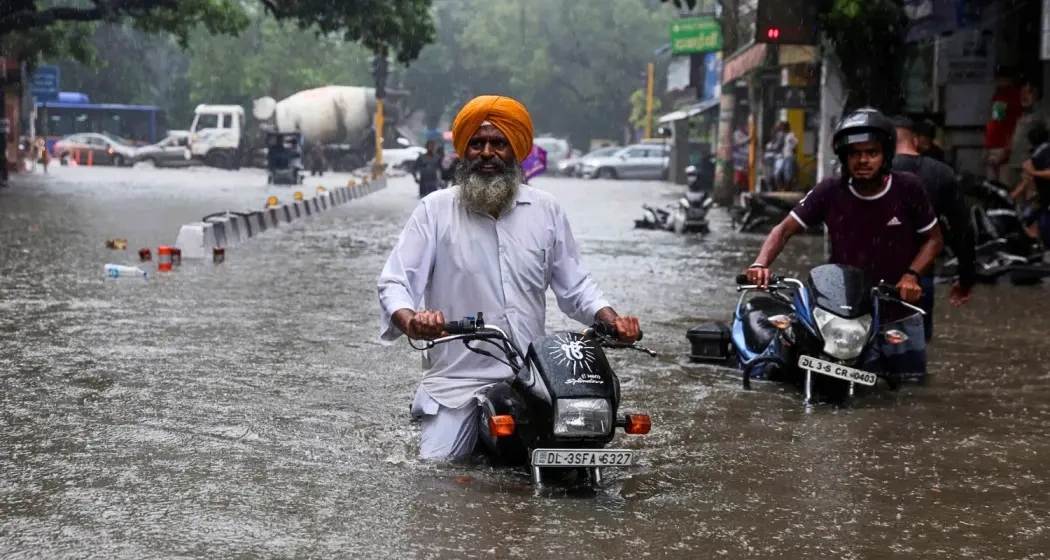10-july-2025,11:00 PM Gurugram remains in the grip of heavy rains for the third consecutive day, disrupting normal life and posing serious challenges for commuters, residents, and civic authorities. In response, the district administration has announced an Orange Alert, urging citizens to stay indoors unless necessary.
This prolonged spell of rainfall has exposed the city’s fragile drainage infrastructure, leading to severe waterlogging in residential colonies, commercial hubs, and major arterial roads. Emergency services are on high alert, while residents are demanding immediate and long-term solutions to combat such recurring monsoon chaos.
Gurugram Under Orange Alert Due to Persistent Heavy Rains
Heavy Rains : What an Orange Alert Means for Citizens
The Indian Meteorological Department (IMD) issues an Orange Alert when heavy rains are expected to continue or intensify, causing potential disruption to daily life. In Gurugram’s case, rainfall has exceeded 70 mm in the past 24 hours, with forecasts indicating more downpours in the next 48 hours.
An Orange Alert is a signal for the local administration to prepare emergency response teams, and for citizens to follow safety advisories strictly. The alert covers multiple parts of Haryana and NCR, where similar rainfall patterns have been recorded.
Heavy Rains : Immediate Actions by District Authorities
The Gurugram District Magistrate convened an emergency meeting with civic bodies, disaster response teams, and traffic authorities. Instructions were issued to deploy water pumps in flooded areas and activate 24/7 helpline numbers for public assistance.
The Municipal Corporation of Gurugram (MCG) has started clearing stormwater drains in heavily affected sectors, including Sector 29, Sector 56, and Udyog Vihar. Schools have been advised to shift to online classes, and offices have been encouraged to opt for work-from-home where feasible.
Impact of Heavy Rains on Infrastructure and Daily Life
Road Closures and Traffic Jams Across the City
The most visible effect of the heavy rains has been the complete chaos on Gurugram’s roads. Key traffic corridors like MG Road, Sohna Road, and Golf Course Road experienced massive traffic snarls due to knee-deep water. Underpasses near Signature Tower and Rajiv Chowk were temporarily shut for safety reasons.
Despite efforts by traffic police, several commuters reported being stranded for hours. Ride-hailing services saw massive delays and surge pricing, adding to public frustration.
Residents Struggle as Homes and Markets Flooded
In low-lying residential sectors like Palam Vihar, Sushant Lok, and DLF Phase 3, residents are battling waterlogged streets and flooded basements. Local markets reported power outages and declining footfall due to the poor weather.
Several residents took to social media to share visuals of water gushing into their homes and parking lots. While the MCG has initiated damage assessments, many are questioning the city’s preparedness for monsoon season.
Experts Link Urban Flooding to Poor Planning
Gurugram’s Drainage Woes a Recurring Story
Every year, heavy rains reveal the gaps in Gurugram’s drainage and urban planning. Experts have pointed out that rampant construction, unregulated encroachments, and lack of proper water discharge systems are key reasons for urban flooding.
An environmental engineer from TERI said, “Gurugram is built over natural water bodies and catchment areas. Concrete surfaces have replaced open lands, leaving rainwater with no place to go.”
Long-Term Solutions Needed Beyond Emergency Pumps
While authorities continue to use pumps and sandbags to manage the current crisis, urban planners are demanding long-term solutions. These include sustainable urban drainage systems (SUDS), rainwater harvesting, and stricter zoning laws.
Civil society organizations have urged the Haryana government to release a white paper on Gurugram’s drainage blueprint and engage with experts to draft a climate-resilient urban development policy.
Weather Forecast and Citizen Advisory
More Heavy Rains Expected in Coming Days
The IMD has forecast that the heavy rains will persist for the next two to three days, with rainfall possibly intensifying during the nighttime. Thunderstorms and gusty winds have also been predicted in isolated areas.
Residents are advised to:
Stay indoors unless essential.
Avoid walking or driving through flooded roads.
Keep emergency kits and chargers ready.
Follow updates from the official disaster helpline: 1077 and Municipal Helpline: 1800-180-1817.
Precautions for Commuters and Students
Students have been told to avoid school if transportation is difficult.
Office-goers are advised to check traffic and weather updates before leaving home.
Two-wheeler riders are especially urged to take extra caution due to slippery roads and potholes hidden under water.
Voices from the Ground Amid the Heavy Rains
Local Business Owners Call for Urgent Relief
Retailers in Sector 14 Market and HUDA Complex reported significant losses due to fewer customers and stock damage from seepage. “I’ve lost half my inventory to water damage,” said one electronics shop owner. “What’s worse is, we face this every monsoon and nothing ever changes.”
Residents Demand Accountability from MCG
Residents’ Welfare Associations (RWAs) have demanded accountability from the Municipal Corporation. In a joint statement, they criticized the civic body for not completing pre-monsoon desilting of drains despite early weather warnings.
Petitions are now circulating online, asking for audits of municipal expenditure and immediate compensation for flood-related property damage.
Conclusion: Gurugram’s Monsoon Crisis Is a Wake-Up Call
The continued heavy rains and the Orange Alert issued by the district administration should serve as a wake-up call—not only to civic authorities but to urban planners, developers, and citizens. While weather events are beyond human control, how a city prepares for and responds to them is very much within our grasp.
Gurugram needs more than just temporary relief measures. It needs a fundamental rethinking of its drainage infrastructure, real estate regulations, and climate resilience strategies. Until then, each monsoon will remain a test the city struggles to pass.
Source : ANI




